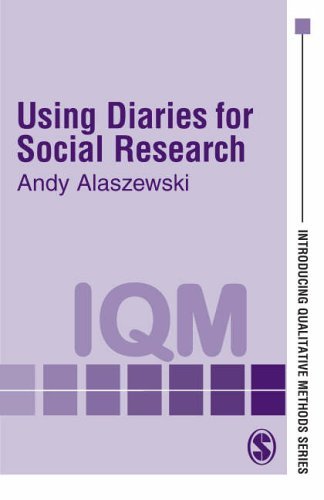Using Diaries for Social Reseach (Introducing Qualitative Methods Series.)
Alaszewski, Andy
Sage Publications, London
2005
0761972919 (pb)
 Using Diaries for Social Research is good little book that I thoroughly recommend to anyone using, or thinking about using, diaries in social research, or to those simply interested in learning more about this particular method. The book is very clear and easy to read. The language is mostly jargon-free, straight to the point, and remains focused on providing key issues involved in using this method. In total, there are six chapters, taking the reader sequentially through particular stages of the research process. Each chapter is headed with an introductory quote that hints at the issues to come. In addition, the 'Key Aims' and 'Key Objectives' at the start of each chapter clearly signal what is to come. Similarly, 'Summary and Comment' and 'Key Points' sections at the end of each chapter also help the reader to further synthesize information. Students and teachers are especially likely to welcome this general format as it greatly facilitates 'reading for learning'.
Chapter One relays a brief history of diary use and an illustrative discussion about what diaries actually are. In Chapters Two and Three, an outline of the strengths of using diaries in various research designs, and possible sources of diary data, are provided respectively. In Chapter Four, issues relating to the actual practicalities and logistics of collecting diary data are discussed. In each chapter, the author cleverly 'speaks' to a wide-ranging cross-disciplinary audience by methodically and explicitly referring to diary use in experimental research, survey research, ethnographic or naturalistic research, and historical research. This way of suggesting that diaries can be used across academic disciplines is refreshing. So often, research methods are 'sold' to particular researchers working within particular disciplinary approaches and their rich potential as tools in themselves is, in turn, also often overlooked. In contrast, here, a particular method is described and discussed precisely as a tool in itself that can be usefully employed to do a number of quite disparate jobs either on its own or combined with other research methods.
Using Diaries for Social Research is good little book that I thoroughly recommend to anyone using, or thinking about using, diaries in social research, or to those simply interested in learning more about this particular method. The book is very clear and easy to read. The language is mostly jargon-free, straight to the point, and remains focused on providing key issues involved in using this method. In total, there are six chapters, taking the reader sequentially through particular stages of the research process. Each chapter is headed with an introductory quote that hints at the issues to come. In addition, the 'Key Aims' and 'Key Objectives' at the start of each chapter clearly signal what is to come. Similarly, 'Summary and Comment' and 'Key Points' sections at the end of each chapter also help the reader to further synthesize information. Students and teachers are especially likely to welcome this general format as it greatly facilitates 'reading for learning'.
Chapter One relays a brief history of diary use and an illustrative discussion about what diaries actually are. In Chapters Two and Three, an outline of the strengths of using diaries in various research designs, and possible sources of diary data, are provided respectively. In Chapter Four, issues relating to the actual practicalities and logistics of collecting diary data are discussed. In each chapter, the author cleverly 'speaks' to a wide-ranging cross-disciplinary audience by methodically and explicitly referring to diary use in experimental research, survey research, ethnographic or naturalistic research, and historical research. This way of suggesting that diaries can be used across academic disciplines is refreshing. So often, research methods are 'sold' to particular researchers working within particular disciplinary approaches and their rich potential as tools in themselves is, in turn, also often overlooked. In contrast, here, a particular method is described and discussed precisely as a tool in itself that can be usefully employed to do a number of quite disparate jobs either on its own or combined with other research methods.
The author continues to break down disciplinary boundaries in Chapter Five by describing both quantitative and qualitative ways of analyzing diary data. Alaszewski's view is that 'How researchers approach the task of analysis depends on the purpose of their research and their perception of the nature of the entries in the diaries' (p. 84). As a whole, what is suggested in this chapter is that researchers have a choice of several approaches to analyzing diaries – from grounded theory, content analysis, conversation analysis, narrative analysis, structural analysis – depending on their skills, preference, background or research objectives, etc. Whilst no approach is dealt with in great detail, the author opens windows of opportunity that researchers can then take and use for their own purposes in their own ways. The final Chapter briefly concludes with some epistemological issues of using diaries. This conclusion sadly weakens rather than strengthens the rest of the book. The crux of the epistemological discussion is tokenistic inasmuch as it is addressed in just four and half pages. The short sections on using diaries from a positivist, social constructionist, and critical realist approach are superficial and do not critically address the question relating to the production of different 'types of knowledge'. That said, the author's overall message is unambiguous: 'Diaries are very flexible ways of accessing information about activities and thoughts and feelings. They can be used in a variety of research designs' (p. 112). Using diaries as a method offers great potential in social research, and I agree with the author that their wider use is to be encouraged. This might not be the definitive book on using diaries in social research but it is certainly a worthy introduction that will hopefully be part of a growing discussion.
Emma Uprichard
Durham University

